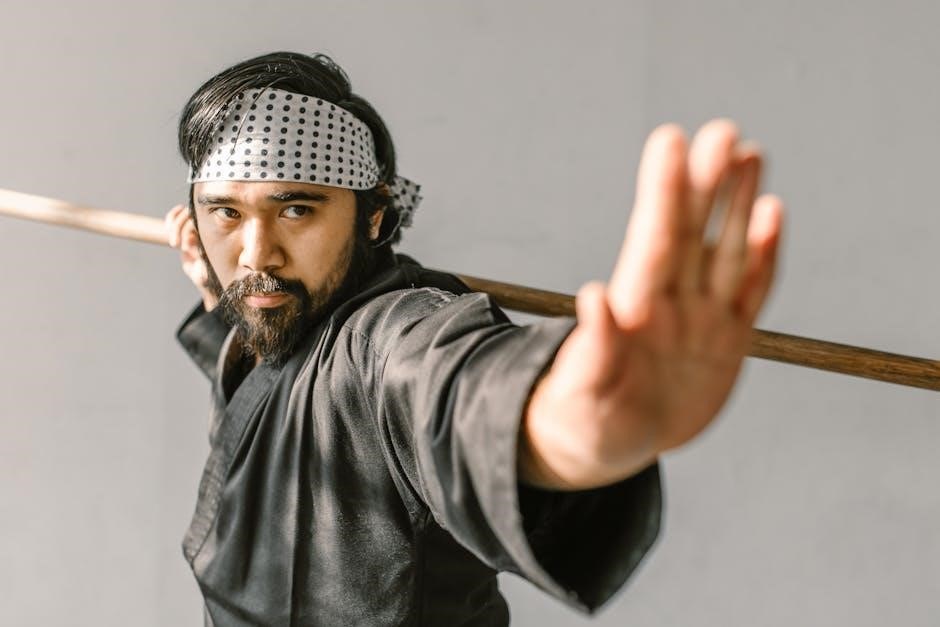Taekwondo kicks are fundamental techniques, with names and pictures available in PDF format, providing a comprehensive guide for practitioners to master various kicks and improve their skills in this martial art form quickly and effectively always online․
Understanding the Basics of Taekwondo Kicks
To understand the basics of taekwondo kicks, it is essential to learn the fundamental techniques and principles of this martial art․ The internet provides a wealth of information, including PDF guides and pictures, to help practitioners grasp the basics of taekwondo kicks․ These resources offer a comprehensive overview of the different types of kicks, including their names, execution, and significance in the art of taekwondo․ By studying these materials, individuals can develop a solid foundation in taekwondo kicks and improve their overall technique․ The basics of taekwondo kicks include understanding the proper stance, balance, and movement, as well as learning how to generate power and speed․ With practice and dedication, practitioners can master the basics of taekwondo kicks and move on to more advanced techniques, ultimately enhancing their skills and performance in this martial art․ The availability of online resources, such as PDF guides and pictures, has made it easier for individuals to learn and understand the basics of taekwondo kicks․
Types of Taekwondo Kicks
Various taekwondo kicks exist, including front, side, and roundhouse kicks, with names and pictures available in PDF format for reference and learning purposes online always easily․
Front Kick and Its Execution
The front kick is a fundamental technique in taekwondo, and its execution requires proper balance and coordination․ To perform a front kick, one must first assume a fighting stance, with the feet shoulder-width apart and the knees slightly bent․ The front kick is then executed by lifting the front leg, keeping it straight, and striking the target with the ball of the foot․ It is essential to maintain proper form and technique to avoid injury and ensure effective execution․ The front kick is also known as the snap kick, due to the speed and power generated by the movement․ With practice and dedication, practitioners can master the front kick and incorporate it into their taekwondo routine․ The front kick is a versatile technique that can be used in various situations, making it a valuable skill for taekwondo practitioners to possess․ Proper training and instruction are necessary to execute the front kick effectively․
Taekwondo Kicks with Korean Names
Korean names like Ap Chagi and Twi Myo Yeop Chagi are used to identify various kicks, providing a unique identity and purpose for each technique in taekwondo training always online quickly․
Exploring the Roundhouse Kick and Axe Kick
The roundhouse kick and axe kick are two essential techniques in taekwondo, with distinct characteristics and requirements․ The roundhouse kick involves a circular motion, generating power and speed, while the axe kick requires a sharp, downward motion, targeting specific areas․ In taekwondo training, mastering these kicks is crucial for improving overall technique and performance․ With the availability of taekwondo kicks names with pictures in PDF format, practitioners can easily access and learn from detailed instructions and illustrations, enhancing their understanding and execution of these kicks․ The roundhouse kick and axe kick are often combined with other techniques, such as the front kick and side kick, to create complex and effective combinations․ By exploring and mastering these kicks, taekwondo practitioners can develop a strong foundation in the martial art and improve their skills in various areas, including sparring and patterns․ Effective training and practice are essential for mastering the roundhouse kick and axe kick․

Importance of Taekwondo Kicks in Martial Arts
Taekwondo kicks are essential in martial arts, enhancing physical fitness, balance, and mental discipline always with online resources and PDF guides available for learning and improvement quickly and effectively every day․
Mastering the Flying Side Kick and Hooking Kick
To master the flying side kick and hooking kick, practitioners must dedicate time to training and practice, focusing on technique, balance, and control․ The flying side kick, also known as Twi Myo Yeop Chagi, requires a combination of speed, power, and agility, making it a challenging yet rewarding technique to learn․ The hooking kick, on the other hand, involves a rotational motion, generating power from the hips and core․ Both kicks are essential in taekwondo, and mastering them can significantly improve a practitioner’s overall skills and performance․ With the help of online resources, such as PDF guides and videos, practitioners can access detailed instructions, pictures, and tutorials to aid in their training, ultimately enhancing their mastery of these complex kicks and achieving a higher level of proficiency in taekwondo․ Regular practice and patience are key to successful execution of these kicks․



